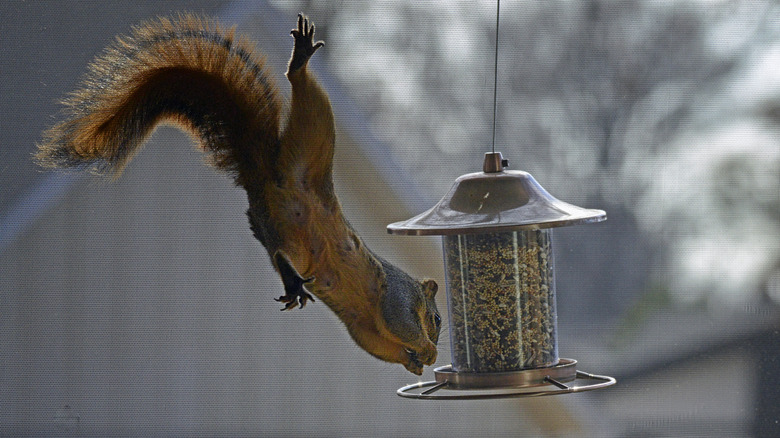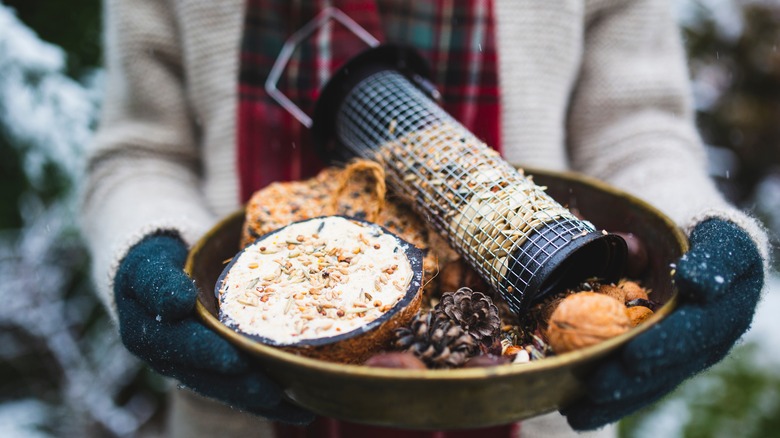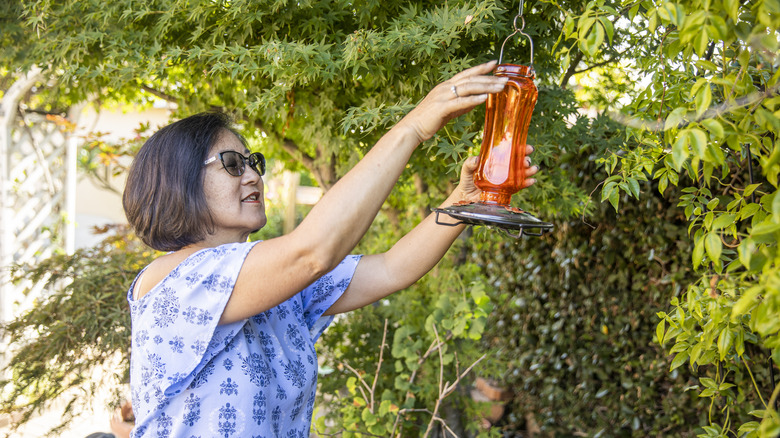Add This Secret Ingredient To Your Bird Feeder To Keep Squirrels Out
Having a bird feeder comes with many benefits. However, dealing with squirrels monopolizing the feeder can be frustrating, especially when you're trying to create a haven for different bird species. If this is your situation, consider adding white proso millet to the mix. It's a favorite among many small bird species, like parakeets, finches, and canaries. It's also a versatile grain and a nutritional powerhouse, rich in proteins, carbohydrates, and essential minerals. Unlike other grains and seeds that might attract a variety of wildlife, including squirrels, white proso millet has the unique advantage of being less appealing to these furry intruders. Squirrels, while cute, can be a huge problem. They are known for their aggressive feeding habits, consuming large amounts of food and dominating the feeder. This not only scares away the birds but also diminishes the initial purpose of having a feeder, leading to increased costs and maintenance efforts on your part.
If you've been considering taking down your bird feeder due to squirrel problems, switching food offers a more sustainable and bird-friendly solution. You can continue supporting local bird populations without the constant battle with squirrels. Feeding birds is crucial, especially during harsh weather conditions when natural food sources are scarce. The best part is that you can mix proso millet with other types of birdseed, creating a diverse and nutritious offering for your feathered visitors. It's a small change that can make a big difference in maintaining a peaceful environment in your yard.
Crafting a squirrel-deterring bird food mix
If you want to add white proso millet to your bird feed, you can use it on its own or mix it with your existing birdseed. To enhance the mix in your DIY bird feeder, consider adding safflower seeds. Like millet, safflower seeds are less attractive to squirrels but loved by a range of birds, including titmice and cardinals. Adding these seeds diversifies the diet for your birds and strengthens the squirrel-repelling properties of your bird feed. Another excellent addition is Nyjer thistle, which is particularly nutritious for goldfinches and other similar species. This addition allows you to cater to a wider variety of birds, ensuring that your bird feeder becomes a hub of avian activity.
To further discourage squirrels, sprinkle a bit of cayenne pepper or another spicy seasoning onto the mix. The hot pepper ingredient capsaicin does not affect birds but isn't so tasty for squirrels. They'll likely look elsewhere if the food isn't satisfying their tastebuds. This method is humane and effective. However, use the spice sparingly to avoid overwhelming the birds' senses. Remember, consistency is key. Regularly refill your feeder with this specially crafted mix to ensure a continuous supply for the birds and to reinforce the message to squirrels that they won't find their preferred food here.
Combining strategies to keep squirrels away
Tackling squirrels at bird feeders often requires a multifaceted approach. Beyond adjusting the bird food, you can also use a squirrel-proof bird feeder. These products are specifically designed to discourage squirrels and come built with weight-sensitive mechanisms that close off access when a squirrel lands on them. Some also have structures that are inherently difficult for squirrels to navigate. You can also apply a slippery substance, like Vaseline, to the poles or stands of your bird feeder to prevent these four-legged pests from climbing up. However, it's important to apply it in a manner that won't hurt them. You'll also need to reapply it periodically, especially after rain or extended periods of use.
The location of your bird feeder also plays a critical role. Keep it away from jump-off points like trees or buildings. Ideally, position your bird feeder at least 10 feet from these areas. This distance makes it more challenging for squirrels to leap onto the feeder. Baffles are another useful addition. These devices, placed above or below the bird feeder, create a barrier that squirrels find difficult to navigate. When installing baffles, ensure they are of sufficient size to prevent squirrels from reaching around them. For a more high-tech approach, consider using motion-activated devices, such as sprinklers or noise-makers, which can also startle and deter squirrels without causing them harm. Place them around the feeder to maintain an area that is less inviting to these agile creatures.


